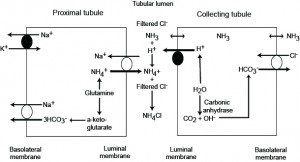The kidney is capable of excreting acid (as ammonium chloride) and generating new bicarbonate (not just reclaiming filtered bicarbonate), when it produces ammonium from glutamine (amino acid) in the proximal convoluted tubules and loop of Henle. This is the primary way by which kidney can generate bicarbonate and excrete hydrogen in acidemia (by increasing renal ammoniagenesis) and how it can decrease acid excretion (and promote bicarbonate loss) in alkalemia (by decreasing renal ammoniagenesis).
In the proximal tubules, ammonium chloride generation is linked to sodium absorption whereas in the distal tubules it is linked to hydrogen excretion (with chloride passively following).
1) In the proximal tubule, ammonium (NH4+) is generated from glutamine. Glutamine is converted to α-ketoglutarate and ammonium by glutaminase and glutamate dehydrogenase. The ammonium is transported into the renal lumen in exchange for sodium by a luminal sodium/ammonium exchanger (NHE3). The ammonium is then excreted into the urine with filtered chloride as its anion. This generates new bicarbonate (via glutamine metabolism), while excreting an acid (ammonium chloride). The bicarbonate is returned to the blood via the basolateral sodium/bicarbonate cotransporter, which derives its energy from a basolateral sodium/potassium exchanger or pump. Some of the ammonium may be absorbed back into blood (reclaimed) in the ascending limb of the loop of Henle by replacing K in the Na-K-2Cl (NKCC2) transporter. Hypokalemia and acidemia stimulates ammoniagenesis, promoting hydrogen excretion and bicarbonate retention. Angiotensin II stimulates the basolateral sodium/bicarbonate cotransporter, facilitating absorption of the generated bicarbonate.
2) In the collecting tubule, ammonia (NH3) diffuses freely across the renal tubular cell from the interstitium and combines with hydrogen excreted by the H+ATPase (chloride passively follows via a paracellular pathway) to produce ammonium. This is excreted as ammonium chloride when it binds to filtered or paracellularly passively leaked chloride. The hydrogen is generated from carbon dioxide and water by carbonic anhydrase. The bicarbonate leaves the cell and enters plasma in exchange for chloride by the basolateral chloride/bicarbonate exchanger (the energy for which is derived from the sodium/potassium pump on the basolateral side, not shown). The hydrogen ATPase pump on the luminal surface and the basolateral chloride/bicarbonate exchanger are both stimulated by aldosterone.
Thus, in both tubules, excretion of hydrogen is linked to generation of new bicarbonate.

